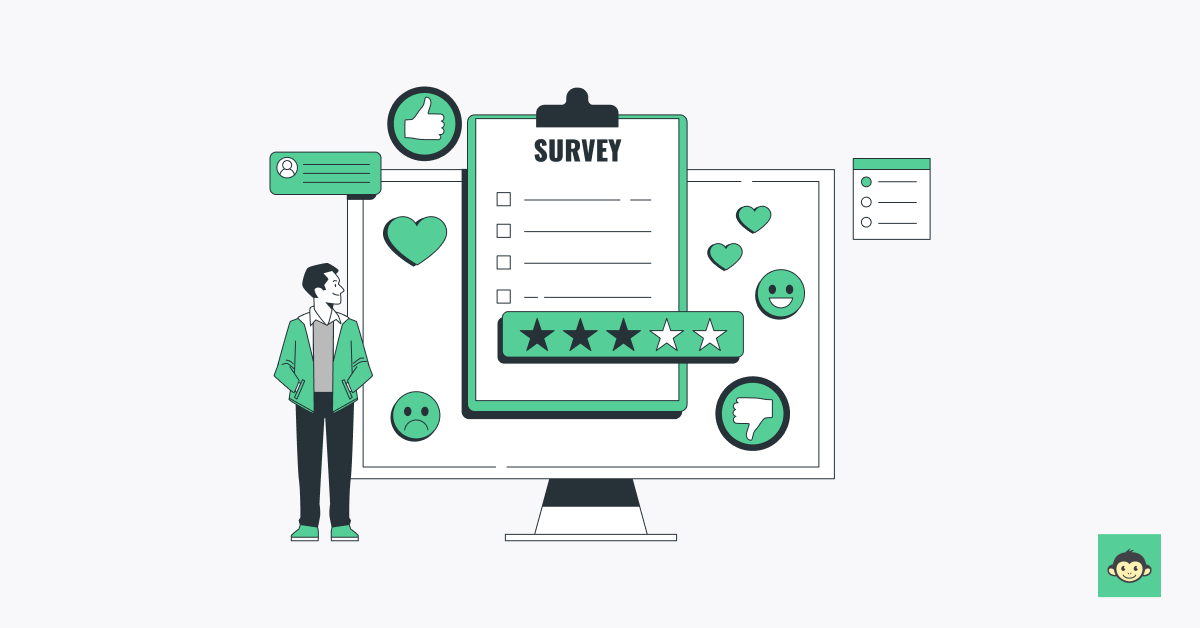10 Reasons to conduct employee engagement survey for small business

Ever feel like you're running a tight ship but your crew seems more interested in checking the time than setting sail on your grand business voyage? Yep, we've all been there, staring into the abyss of uninspired team members.
Now picture this: Your business, humming with energy, every employee a beacon of enthusiasm.
How do you make this dream a reality, you ask?
Cue the drumroll for the unsung hero of small business success: the employee engagement survey!
In this blog, we're not just talking about any old survey. We're diving headfirst into why conducting employee engagement surveys can turn your sluggish operation into a turbocharged powerhouse.
So, grab your metaphorical sailor hat, because we're about to navigate the choppy waters of workplace engagement!
Why use surveys to measure employee engagement in small businesses?
For a small business, a team is family. You know each other's coffee orders, celebrate milestones together, and maybe even share the occasional inside joke about the printer. But beneath the surface of camaraderie, a powerful force drives success: employee engagement.
And understanding it in your close-knit team can feel like peering into a black box. This is where surveys, your unsung heroes, step in. Forget complex spreadsheets and awkward water cooler conversations. Employee engagement surveys are the whisperers of the workplace, revealing the hidden currents of motivation, satisfaction, and loyalty that fuel your small business.
So, ditch the guesswork and let's dive into why surveys are the key to unlocking the secrets of engagement in your team.
How to design your employee engagement survey questions?

Designing effective employee engagement survey questions is crucial to gather valuable insights into your team's satisfaction, motivation, and overall engagement. Here's a guide on how to design your employee engagement survey questions:
Start with the basics:
Begin your survey with fundamental questions that cover the basics of employee engagement, such as job satisfaction, understanding of company goals, and alignment with organizational values. For example:
- How satisfied are you with your current role and responsibilities?
- To what extent do you feel aligned with the company's mission and values?
Measure job satisfaction:
Gauge how content employees are with their specific roles and the work environment. This helps identify areas that may need improvement. Sample questions include:
- On a scale of 1 to 10, how satisfied are you with your day-to-day work?
- Do you feel your skills are utilized effectively in your current role?
Assess communication and recognition:
Explore how well information flows within the organization and whether employees feel recognized for their contributions. Examples include:
- How well do you think information is communicated across different teams or departments?
- Do you feel adequately recognized for your achievements and efforts?
Explore work-life balance:
Inquire about the work-life balance of employees, as this directly impacts their engagement and well-being. Ask questions like:
- How would you rate your current work-life balance?
- Do you feel supported in managing your workload and personal life?
Evaluate team dynamics:
Understand the dynamics within teams, as a positive team environment fosters engagement. Consider questions like:
- How well do you collaborate with your team members?
- Do you feel a sense of camaraderie and teamwork in your department?
Focus on career development:
Assess whether employees see growth opportunities within their career path of the organization and if they are satisfied with their career paths. For instance:
- Do you feel the company provides adequate opportunities for career development?
- How satisfied are you with the training and development programs offered?
Include employee feedback:
Encourage employees to share their thoughts on how the company can improve. This allows for open-ended responses and valuable suggestions. Ask:
- What suggestions do you have for improving the work environment or company policies?
- Is there anything else you would like to share about your experience working here?
Anonymity and confidentiality:
Assure employees that their responses will remain confidential. This encourages honest feedback. Include a question like:
- How comfortable do you feel providing honest feedback in this survey?
Use a mix of question types:
Employ a variety of question types, including multiple-choice, Likert scale, and open-ended questions. This ensures a comprehensive and clear understanding of employee sentiments.
Regularly update the survey:
Keep the survey dynamic by updating questions based on feedback and organizational changes. This reflects a commitment to continuous improvement.
Remember, the goal is to create a survey that not only captures data but also provides actionable insights to enhance employee engagement in your small business.
How do you conduct employee engagement surveys for your small business?

Conducting an employee engagement survey for your small business requires careful planning and thoughtful execution. Here's a step-by-step guide to help you conduct an effective survey:
- Define objectives: Clearly outline the objectives of your employee engagement survey. Determine what specific aspects of engagement you want to measure and what goals you aim to achieve with the survey results.
- Select or create survey questions: Based on the defined objectives, choose or create survey questions that align with your goals. Use a mix of quantitative (multiple-choice, Likert scale) and qualitative (open-ended) questions to gather comprehensive insights.
- Ensure anonymity: Communicate to your employees that their responses will be kept confidential and anonymous. This fosters trust and encourages honest feedback.
- Choose the right timing: Pick a time to conduct the survey when employees are not under excessive stress or workload. Avoid busy seasons or critical project deadlines to ensure higher participation.
- Select a survey platform: Choose an appropriate survey platform or tool to administer the survey. There are various online survey tools that offer easy customization, data analysis, and reporting capabilities. Some popular options include Google Forms or specialized employee engagement platforms.
- Communicate clearly: Clearly communicate the purpose of the survey, its importance, and the expected timeline to all employees. Emphasize the value of their input in shaping the workplace environment.
- Set realistic expectations: Manage expectations by informing employees about the intended outcomes of the survey. Let them know how the feedback will be used to improve the work environment.
- Encourage participation: Motivate employees to participate in the survey. Highlight its significance and how their feedback will contribute to positive changes. Consider offering incentives or rewards for participation to boost engagement.
- Monitor survey progress: Keep track of the survey completion rates and follow up with reminders to those who haven't participated. Ensure that everyone has an equal opportunity to share their thoughts.
- Analyze results: Once the survey period concludes, analyze the results. Look for patterns, trends, and key insights. Identify areas of strength and areas that require improvement.
- Communicate findings: Share the survey findings with the entire team. Be transparent about the results, emphasizing the positive aspects and addressing areas of concern. This demonstrates a commitment to transparency and improvement.
- Develop action plans: Based on the survey results, create action plans to address specific issues or enhance positive aspects. Involve other employees in the process to ensure collective ownership and commitment to improvement.
- Implement changes: Act on the action plans and make tangible changes based on the survey feedback. Communicate these changes to employees to demonstrate that their input has a direct impact on the workplace.
- Follow-up: Conduct follow-up surveys at regular intervals to track progress and assess the effectiveness of implemented changes. This ongoing feedback loop helps in continuous improvement.
- Celebrate success: Acknowledge and celebrate improvements and achievements resulting from the survey. Recognize the collective effort of employees in shaping a positive work environment.
By following these steps, you can conduct an employee engagement survey that not only provides valuable insights but also contributes to a culture of transparency, continuous improvement, and employee satisfaction in your small business.
How to get the most out of employee engagement surveys?

- Strategic survey design: Craft survey questions strategically, ensuring alignment with the specific goals and objectives of your small business. Tailor questions to measure employee engagement, satisfaction, and areas for improvement, incorporating a mix of quantitative and qualitative formats.
- Prioritize anonymity and trust: Reiterate the confidentiality of survey responses to foster trust among employees. Anonymity encourages honest feedback, providing a more accurate representation of employee sentiments.
- Encourage honest feedback: Create a culture that values candid feedback. Assure employees that their input is crucial for positive change, and emphasize the importance of their honest opinions in shaping the workplace.
- Set clear expectations: Clearly communicate the purpose of the survey and the expected outcomes. Outline how the collected data will be used to drive improvements, fostering a sense of purpose and participation among employees.
- Timely and regular surveys: Conduct surveys at regular intervals to track changes in employee engagement over time. This allows you to identify trends, measure the impact of implemented changes, and address emerging issues promptly.
- Tailor questions to company culture: Customize survey questions to reflect the unique aspects of your company culture. This ensures that the survey is relevant and resonates with employees, providing insights specific to your small business environment.
- Use benchmarking data: Leverage benchmarking data to compare your small business's engagement levels with industry standards or similar-sized companies. This contextualizes your results and offers insights into areas where improvement is needed.
- Involve employees in action planning: Engage employees in the interpretation of survey results and the development of action plans. This participatory approach fosters a sense of ownership and commitment to the improvement process.
- Prioritize key areas for improvement: Identify key areas for improvement based on survey results. Focus on addressing high-impact areas that contribute significantly to overall employee engagement and satisfaction.
- Effective communication of changes: Clearly communicate the changes resulting from the survey, detailing how employee feedback influenced decision-making. This transparency reinforces the connection between feedback and positive outcomes.
- Measure employee experience continuously: Extend the measurement of employee engagement beyond surveys. Implement regular check-ins, pulse surveys, or feedback sessions to maintain an ongoing understanding of employee sentiments.
- Recognition and appreciation: Acknowledge and appreciate employees for their contributions, both during and after the survey process. Recognizing their efforts reinforces a positive workplace culture and encourages continued engagement.
- Integrate survey insights into performance reviews: Integrate relevant survey insights into employee performance reviews. This demonstrates that employee engagement is a valued aspect of individual and collective success within the organization.
- Flexibility and adaptability: Stay flexible and adapt the survey approach based on changing organizational dynamics, industry trends, or employee needs. A dynamic survey strategy ensures relevance and effectiveness over time.
- Continuous improvement loop: Establish a continuous improvement loop by incorporating lessons learned from each survey cycle into the planning and execution of subsequent surveys. This iterative approach enhances the impact of engagement initiatives.
By implementing these strategies, your small business can not only conduct effective employee engagement surveys but also leverage the collected data to foster a positive workplace culture, enhance employee satisfaction, and drive continuous improvement.
Understanding engagement questions vs employee feedback questions

Employee engagement questions and employee feedback questions serve distinct purposes in understanding and improving the workplace environment. Let's explore the differences between the two:
Employee engagement questions:
Focus on emotional connection: engagement questions aim to measure the emotional connection employees perceive they have with their work, team, and the organization as a whole.
Example: "How motivated do you feel in your current role?"
Assess overall satisfaction: these questions gauge employees' overall satisfaction with their job, workplace, and the company's performance and culture.
Example: "On a scale of 1 to 10, how satisfied are you with your work environment?"
Measure commitment: engagement questions often seek to understand the level of commitment and loyalty employees feel towards the organization.
Example: "Do you see yourself working for this company in the next 5 years?"
Explore team dynamics: these questions may delve into the dynamics within teams and how well employees collaborate with their colleagues.
Example: "How well do you feel supported by your team members?"
Assess alignment with company values: engagement questions often explore whether employees align with the organization's mission, vision, and values.
Example: "To what extent do you feel connected to the company and organization's vision and core values?"
Capture intrinsic motivation: questions in this category aim to uncover the factors that intrinsically motivate employees in their daily work.
Example: "What aspects of your job bring you the most satisfaction?"
Employee feedback questions:
Specific and actionable: Employee feedback questions are often more specific and designed specifically to gather actionable insights for improvement.
Example: "What specific changes do you think could enhance the efficiency of our team meetings?"
Address areas for improvement: Feedback questions target areas where the organization can make tangible improvements based on employee input.
Example: "How can we enhance communication between different departments?"
Encourage suggestions and ideas: These questions invite employees to share their thoughts, suggestions, and innovative ideas for positive change.
Example: "What initiatives do you believe would contribute to a more inclusive workplace?"
Capture perceptions and experiences: feedback questions often focus on employees' perceptions and experiences, helping to identify strengths and weaknesses.
Example: "How would you describe the level of support and training opportunities you receive from your immediate supervisor?"
Enhance leadership and management: Questions in this category may target the effectiveness of leadership and management, seeking ways to improve leadership practices.
Example: "In what ways can leadership better support your own professional growth and development?"
Provide constructive criticism: employee feedback questions aim to elicit constructive criticism, offering employees a platform to voice concerns.
Example: "What challenges do you currently face in your role, and how can we help address them?"
In summary, while employee engagement questions assess employees' overall connection and satisfaction, employee feedback questions are more targeted, aiming to uncover specific areas for improvement and gather actionable insights to enhance the work environment. Both types of questions are valuable components of a comprehensive approach to understanding and improving the employee experience.
Top 10 reasons to conduct employee engagement survey for small businesses

Here are 10 compelling reasons to conduct these surveys, propelling your team towards enhanced satisfaction, productivity, impact engagement and success.
- Enhance employee satisfaction: Conducting your own employee engagement survey allows you to review and understand the factors contributing to job satisfaction, ensuring a content and motivated workforce.
- Measure engagement effectively: Use quantitative data from employee surveys to review and measure engagement accurately, providing a clear snapshot of your team's level of commitment and involvement.
- Identify development opportunities: Employee engagement surveys are a valuable tool to review and identify areas for development opportunities, ensuring continuous growth and skill enhancement within your small business.
- Boost employee retention: Regularly measuring employee engagement helps review factors affecting retention, allowing for targeted efforts to enhance workplace satisfaction and reduce turnover.
- Optimize team productivity: Conducting employee surveys enables you to review and identify ways to enhance productivity, creating a positive and collaborative work environment that fosters highly productive teams.
- Facilitate anonymous feedback: Implementing anonymous surveys ensures honest and unbiased feedback, providing a platform for employees to review and express their opinions without fear of repercussions.
- Tailor employee survey questions: Crafting specific employee survey questions allows you to review and delve into crucial aspects such as job satisfaction, team dynamics, and career growth, tailoring inquiries to your small business's unique culture and goals.
- Conduct annual surveys strategically: Annual surveys help review and track changes in employee engagement over time, providing valuable insights to guide strategic decisions and initiatives within your small business.
- Recognize highly engaged employees: Employee engagement surveys help identify and acknowledge highly engaged employees, fostering a culture of appreciation and recognition within the organization.
- Foster constructive feedback: Encourage managers to review and utilize constructive feedback from employee surveys, fostering open communication and driving continuous improvement for a workplace where employees feel valued.
40+ employee engagement survey question examples for small businesses

Here's a list of 40+ employee engagement survey question examples tailored for small businesses. Feel free to customize them based on the specific needs and context of your Organization:
- On a scale of 1 to 10, how satisfied are you with your current role?
- Do you find your work meaningful and fulfilling?
- How motivated do you feel in your day-to-day tasks?
- How satisfied are you with your work-life balance?
- Do you feel your skills are effectively utilized in your current role?
- To what extent do you enjoy the tasks assigned to you?
- How well do you think information is communicated across different teams or departments?
- Do you feel adequately recognized for your achievements and efforts?
- How often do you receive feedback on your performance?
- How well do you collaborate with your team members?
- Do you feel a sense of camaraderie and teamwork in your department?
- How would you rate the effectiveness of team communication?
- Do you feel the company provides adequate opportunities for career development?
- How satisfied are you with the training and development programs offered?
- Are you clear about your career growth within the organization?
- On a scale of 1 to 10, how comfortable do you feel in the workplace?
- How well does the physical environment support your productivity?
- Are you satisfied with the resources provided to perform your job?
- How would you rate the effectiveness of the company's leadership?
- To what extent do you feel your opinions are valued by leadership?
- Are you confident in the vision set by the company's leadership?
- How would you rate the support for your mental and emotional well-being?
- Do you feel the company promotes a healthy work-life balance?
- How satisfied are you with the benefits and perks offered?
- To what extent do you feel the workplace is inclusive and diverse?
- Are you satisfied with the company's efforts to promote diversity and inclusion?
- Do you believe there are equal opportunities for all employees?
- How well does the company culture align with your values?
- Do you feel a strong sense of belonging to the organization?
- How would you describe the overall culture within your team?
- How comfortable do you feel providing honest feedback in this survey?
- What suggestions do you have for improving the work environment or company policies?
- Is there anything else you would like to share about your experience working here?
- How satisfied are you with the support provided for remote work?
- Do you feel adequately connected to your team while working remotely?
- Are the tools and technologies provided conducive to effective remote work?
- How satisfied are you with the recognition and rewards programs in place?
- Do you feel your efforts are appropriately acknowledged by the organization?
- Are the current incentive programs motivating for you?
- To what extent do you feel connected to the company's core values?
- How well do the company's values align with your personal values?
- Do you believe the company upholds its stated values in day-to-day operations?
Feel free to mix and match these questions to create a comprehensive employee engagement survey that aligns with the unique characteristics and goals of your small business.
Why the question scale matters in an engagement survey?

The question scale in an engagement survey plays a crucial role in obtaining accurate and meaningful insights from employees. The scale provides a standardized way for employees to express their opinions or feelings on a given topic.
Here are several reasons why the question scale matters in an engagement survey:
- Consistency and comparability: A standardized question scale ensures consistency in responses. Using the same scale across various questions allows for meaningful comparisons between different aspects of the work environment. It helps maintain uniformity in data interpretation.
- Quantifiable data: Scales, especially numeric ones, provide quantifiable data. This allows for the transformation of qualitative responses into measurable metrics. Numeric scales make it easier to analyze trends, identify patterns, and track changes over time.
- Statistical analysis: Scaled responses enable statistical analysis. Metrics such as averages, medians, and standard deviations can be calculated, providing a more in-depth understanding of the distribution and variability of responses. This allows for more robust and nuanced data interpretation.
- Ease of interpretation: Employees find it easier to interpret and respond to questions presented in a scaled format. It simplifies the feedback process, reducing the cognitive load on respondents. This, in turn, increases the likelihood of honest and accurate responses.
- Precision in measurement: Scales offer a level of precision in measurement. For instance, a Likert scale ranging from 1 to 5 allows respondents to express gradations in their opinions. This precision can capture subtle nuances that might be lost in binary (yes/no) or open-ended response formats.
- Facilitates benchmarking: Standardized scales facilitate benchmarking against industry standards or previous survey results. This helps organizations assess their performance relative to external benchmarks or their own historical data, guiding efforts for continuous improvement.
- Facilitates comparative analysis: Scaled responses enable comparative analysis between different groups or departments within the organization. This can highlight variations in engagement levels and guide targeted interventions in areas that may need attention.
- Reduces ambiguity: The use of a scale minimizes ambiguity in responses. It provides a structured framework for employees to articulate their sentiments, reducing the likelihood of misinterpretation or miscommunication.
- Efficient data processing: Scaled responses are more straightforward to process and analyze, especially when dealing with a large volume of survey data. Automated tools and statistical software can efficiently handle scaled data, saving time and resources.
- Enhances survey validity and reliability: A well-designed question scale contributes to the overall validity and reliability of the survey. Validity ensures that the survey measures what it intends to measure, while reliability ensures consistent results over time and across different respondents.
Conducting employee engagement surveys step-by-step

Let’s go one step at a time to conduct our employee engagement survey.
- Objective definition: Clearly define the survey objectives, focusing on keywords like "employee satisfaction" and "motivation."
- Question selection: Choose or design survey questions aligned with defined objectives, incorporating keywords such as "team dynamics."
- Anonymity assurance: Emphasize the importance of anonymity to build trust among participants.
- Strategic timing: Pick a suitable time for the survey, using best practice, avoiding busy periods and ensuring optimal participation.
- Platform selection: Choose a user-friendly survey platform or tool, utilizing keywords like "survey platform."
- Transparent communication: Communicate the survey's purpose, expectations, and timeline transparently to all employees.
- Expectation management: Manage expectations by informing employees about anticipated outcomes and how feedback will drive improvement.
- Participation encouragement: Motivate participation by highlighting the value of employee input and consider using incentives to improve engagement.
- Progress monitoring: Monitor survey progress closely, sending reminders to enhance participation and response rates.
- Results analysis: Analyze survey results, focusing on keywords like "analyze results" to identify patterns and trends.
- Clear communication of findings: Communicate survey findings transparently, addressing both positive aspects and areas for improvement.
- Actionable plans: Develop actionable plans based on survey insights, turning feedback into tangible improvements.
- Implementation of changes: Act on plans to implement changes, emphasizing the organization's commitment to improvement.
- Ongoing follow-up: Conduct regular follow-up surveys to track progress and gather continuous feedback.
- Celebration of progress: Celebrate successes stemming from survey-driven improvements, recognizing collective efforts.
By following these concise steps, your employee engagement survey process can be efficient, targeted, and result-oriented.
Using surveys to develop engagement strategies

Leveraging surveys to develop engagement strategies is a strategic process involving careful identification of objectives and the design of targeted survey questions.
By assessing current engagement levels and analyzing responses, organizations can prioritize key areas for improvement.
Engaging employees in action planning ensures collaborative solutions, and clear, achievable goals are established based on survey insights. Transparent communication of strategies, continuous feedback contributing to a highly engaged workforce.
Free employee engagement survey for small business - Top 5 tools

Several employee survey tools offer free versions of their own employee engagement survey features, catering to the needs of small businesses. Here are 5!
1. Google Forms
Free tier features:
- Unlimited surveys and feedback loops, and the implementation of tailored initiatives contribute to a positive work culture. Monitoring and adjusting strategies based on ongoing survey data help organizations create an environment that aligns with employee expectations and fosters satisfaction, and ultimate questions.
- Basic survey customization.
- Real-time response collection and basic analytics.
Benefits: Integration with other Google Workspace tools, simplicity, and widespread accessibility.
2. Typeform
Free tier features:
- Basic survey creation with a user-friendly interface.
- Limited questions per survey.
- Basic analytics.
Benefits: A visually appealing and interactive survey design.
3. Qualtrics (Free account)
Free tier features:
- Basic survey creation and customization.
- Limited responses per survey.
- Basic reporting and analytics.
Benefits: Robust features, user-friendly, and the ability to scale as your business grows.
4. Zoho Survey
Free tier features:
- Basic survey creation and customization.
- Limited questions per survey.
- Basic analytics and reporting.
- Benefits: Part of the Zoho suite, integration with other Zoho apps, and ease of use.
5. SurveyMonkey
Free tier features:
- Basic survey creation and customization.
- Limited question types.
- Responses collection and basic analytics.
- Benefits: User-friendly interface and a straightforward survey creation process.
Before selecting a tool, consider your specific requirements, such as the level of customization needed, the number of surveys and questions allowed, and the analytics features provided.
Conclusion
Prioritizing employee engagement is paramount for the success and well-being of any small business.
Utilizing employee engagement surveys is an effective way to understand your team's dynamics, satisfaction, and motivation levels. While various survey tools are available, CultureMonkey stands out as a platform that places a strong emphasis on cultivating a positive workplace culture.
CultureMonkey’s employee survey tool offers a comprehensive suite of features specifically designed to elevate your employee engagement efforts. Reach out today.



